LIKE FACEBOOK PAGE * Join Free Newsletter
RSS Links * Hogue’s Author Page
Support HogueProphecy
GET AN ONLINE READING WITH JOHN HOGUE
Email him at hoguebulletin@hogueprophecy.com
Put “Hogue Reading” in Subject line
He’ll send you times, prices and information.
DATELINE: 30 July 2023
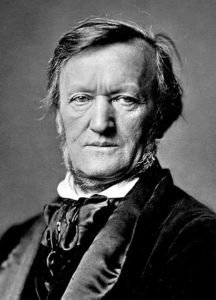
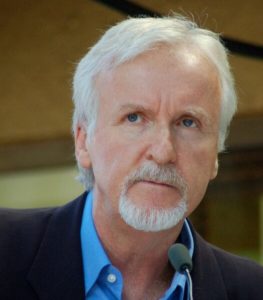
(Upper Left) Richard Wagner. (Center) Na’vi created by a fan. Author Harry Nguyen. Source: originally posted to Flickr as “my avatar,” © Creative Commons. (Upper Right) James Cameron at a ceremony for Gale Anne Hurd to receive a star on the Hollywood Walk of Fame. Author Angela George, © Creative Commons.
FROM
THE RING OF THE NIBELUNG SAGA
TO
THE AVATAR SAGA
An Overview Written in Poetic Stream of Consciousness
After my Mentor: Ray Bradbury Style
Constantly Reminding
—Write! Don’t Think! —
Of what makes James Cameron and the Avatar Saga
The Next Step after Richard Wagner’s Ring Cycle
In Advancing the Total Art Form of the Future
EPISODE ONE
Contemplating James Cameron’s Avatar Saga and the many years it has already taken, and will further take to see accomplished, I am reminded of a great and kindred genius who revolutionized the performing arts back in the nineteenth century. He was a trailblazer paving the way for Cameron and his Avatar Saga with a great Saga of his own: The Ring of the Nibelung (Der Ring des Nibelungen). I speak of Richard Wagner, the German Gemini of multiple personality with many roles to play: the poet, librettist, stage director, designer, orchestral and choral conductor; the author, polemical essayist, a creator of a new classical instrument as well as inventing the ways of modern conducting and the concept of a travelling guest conductor so ubiquitous for our time but quite unorthodox and intriguing in his.
He is the first man who turned his back on the audience when conducting an orchestra, allowing more room for interpretating classical pieces and tempi. And after he turned his back, all conductors since have followed his lead and became more than a mere metronome facing the audience counting time. They are captains of orchestral sound.
Because of the power of just one harmonic cord, Wagner opened the ears of the classical music world. His “Tristan” cord is considered the moment modern music was born.
I would only add a personal observation, at fifteen years old, he changed my life opening me up to a depth of feeling and ecstasy that can be a moment-to-moment light of one’s life and causeless, constant joy if one but dare see and hear it.
Wagner came before Cameron, and I dare say, he paved the way for what wonders he’s bringing through the revolution of CGI magic. From steps taken by Richard Wagner’s nineteenth-century Music Drama conception breakthrough, when classical music was at its most popular peak, Wagner now hands over to James Cameron an opportunity to make performing art history rhyme in another evolutionary jump in a related art form in the early twenty-first century, right when CGI cinema approaches its peak in world popularity.
Like Cameron, Wagner’s vision of performing arts transcended the technological capabilities of his time. So he had to reinvent it. In his lifetime process Wagner had to do even what no Opera composer past or present has done, visualize and finally achieve the construction of a new kind of “Festival House” built specifically for his “music dramas,” taking what had only been theory and making it reality, in the realm of acoustical theatrical design.
James Cameron succeeded in advancing underwater filming to a level of realism never before achieved. Like Wagner did with acoustics, he had to create a whole new concept of a shooting studio either high and dry or deep tanked oceanic, transforming motion capture filming.
We’re talking about magicians here, past and present.
Wagner conjured the construction of a new brass instrument that mated the trombone’s open-your-eyes bright, soaring call, but with a far darker range—warmed, rounded with mellowness of French horns—called the Wagner Tuba.
And he made the orchestra in his new theater disappear!
Wagner designed and then performed his Ring saga with a stage possessing the first truly sunken orchestra pit where as many as 127 instruments could be heard rising out of nowhere filling his Festival House made so much more acoustically alive by design, aiding the vocalists who could see the conductor from stage where the audience did not. More easily were they heard over that orchestra farther below, making it possible not to strain their voices, given Wagner’s unprecedentedly massive orchestration. As a former professional Opera singer, it is a good thing to have less straining because Wagner’s epic Nordic-Germanic Saga must be performed over four days.
Altogether it is a musical marathon of 15 hours of music. It took Wagner 25 years to compose it, within which he dropped the project for 11-years before taking work up on it up again. “The Ring” was finally performed in its entirety at his new Festival House in Bayreuth, Bavaria, August 1876.
Music Drama wasn’t Opera.
It was Wagner’s dream to create a concept a century ahead of his time. The work began in 1849. He had just avoided being caught and thrown in prison for standing as one of three revolutionary leaders of a citizen revolution demanding more freedom from the Saxon monarchy. They made their stand in Dresden, capital of Saxony. It would be one of many revolutions of the “the European Spring” as it was called, that spread across the continent, starting in France and later stretching out to cry rebellion throughout the German states and the Austrian Empire.
That time had an astrological bridge to ours. For Neptune had just returned to its home sign of Pisces. In astrological sense Neptune returns to Pisces every 164 years demanding a revolutionary jump in the art of mass communication. A doorway opens for new ideas, new art forms, new ways to communicate them as they arise out of the collective dream of humanity, the collective unconscious that Pisces rules.
Ideas and messages from Existence swim like fish in a fathomless sea. They are hidden angels, both divine and fallen, of the subconscious. They wish to speak. They seek mediums to conjure them. They wait every 164 years for a transit of Neptune through Pisces that takes around 13 years. Wagner’s revolution under Neptune’s return in 1849 first began on the streets of Dresden, later transmuting that experience to reunite the great arts of Music, Drama, Spectacle and Dance, into a new kind of performance that all began in the first intense degrees of Neptune beginning its transit through its home sign of Pisces.
James Cameron’s dreams of revolutionizing the cinematic arts was also hastened by the next return of Neptune into Pisces after Wagner’s time. After many years of evolving the concept of the Avatar Saga, Cameron at last began principal development in 2014 of the first of what would be five planned movies, also right at the early degrees of the Neptune’s return to Pisces since 1849, in 2014! With Neptune’s blessing, his cinematic revolution had begun in earnest.
Every birth is a revolution. Every “revolving” back into new life has blood involved, be it metaphorical or literal. In Wagner’s case both were present. He along with the Russian philosopher of Anarchy, Mikhail Bakunin, were two the three leaders of the Saxon citizens rebellion that saw members of the labor and middle classes take up muskets and man the barricades in Dresden. They were heroically overthrown by superior forces. The King of Saxony sent letters to his neighbor, the King of Prussia, asking him to unleash his spike-helmeted army in full force of volley fire and cannons crashing down the barricades to rid him of the revolutionaries.
Bakunin was arrested.
Wagner’s best friend, the fellow romantic composer Franz Liszt, arranged his escape to exile in Zurich, Switzerland, just missing his own arrest and long life-and-art wasting years languishing in prison. He would seek and gain asylum in Switzerland where he would not be able to step foot in any German kingdom for decades, branded a terrorist, a revolutionary.
Wagner, the man who dared trying to change things politically, rather than sit back and satisfy his wife’s mistake of marrying a rebellious genius, was not the kind of average man, happy enough with a comfy job, good pay, a nice retirement pension to come as the Saxon king’s Royal Kapellmeister (conductor) of the Royal Saxon orchestra.
Good Minna Planter-turned-Mrs. Minna Wagner, you don’t tame and marry a Phoenix bird who will utterly burn to ashes one day, only to soar in the sky of a new artistic inspiration again without your bourgeois leash to hold him down. Wagner always loved her, was sorry for her choice of him, but such men are a force for marriage dreams to be reckoned with.
Let revolutionary passion burn his bridges, destroying his comfy career, setting the married couple into an uncertain future. He had the light of his visions of a new and wholistic art form to light his way. He once upon a time was that up-and-coming composer of innovative and harmonious, highly dramatic romantic German operas like, Rienzi, The Flying Dutchman, Tannhäuser and just before the 1849 revolution, Lohengrin. These were just a preparation, like James Cameron’s movies like The Abyss, Terminator I and II, and Titanic. Call Wagner’s operas and Cameron’s movies the launch pad for taking off to higher, riskier, flights of artistic fancy.
Once newly exiled from the German world and its theaters it was left to Liszt to conduct Lohengrin in Weimar Germany for its premier performance in 1850. Signs of what might be coming out of Wagner were hidden in the freshly printed score held by his best friend’s hands, hinting of what would come in his mature works. A dozen years or so would pass without ever hearing Lohengrin in his ears until Wagner heard it for the first time in full orchestral richness being played at an opera house somewhere during a dress rehearsal. Sitting in the dark theater, Wagner was seen often turning his face away, planting it in the theater seat, his back shuttering in silent sobs of joy.
“Exile, outcast, alien…”
This almost sounds like the lines of an eight-foot, blue Na’vi human in an Avatar body, walking away, kicking up ash, after Home Tree was destroyed by the sky people, commanded by Miles Quaritch.
It was the reality of a short and nimble man with an unusually large head. He had penetrating blue eyes, a flowing blond mane, marking him as the perfect model for the first cartoon caricatures of what a classical conductor should look like. Through his own artifice in grooming, the cartoonists will further extend his prominent jaw and chin in caricature because Wagner eccentrically grew his sideburns to meet under his lower jaw to complete a hairy frame of it.
Like Jake Sully, Wagner was not broken by exile’s tragedy. The audacious visionary was only just beginning to take leaps off his Ikran to jump Turuk from above, because, hey! When you are the baddest Irkan flying over Planet Pandora, who looks up at the blue Avatar attempting to sneak in a bonding with you and become Turuk Makto?
Wagner in Zurich managed to accrue enough donations from friends and admirers, also finding well-to-do fans in the German-Swiss Canons, to set himself up. Yet Wagner’s ever uncertain financial situation caused him to create something in classical music that today we’ve long taken for granted. He created the concept of the “travelling guest conductor.” Avoiding the German states, and sometimes his creditors too, for he ever was an incurable spendthrift, he traveled by train and overland carriage across Europe to do concerts including favorite romantic pieces of the time “and” a selection of his own overtures and works. So on the one hand he was spreading his musical-dramatic “revolution” in the concert halls as far north as St. Petersburg to Albert Hall in London, where he had an audience with Prince Albert and Queen Victoria of Britain. He would guest conduct in Paris as well, and Vienna. On the other hand, beyond the necessary and basic financing of his composition work, plus keeping him and Minna housed and fed, his artistry required inspiration from fancy berets and clothes. This Gemini air sign gained inspiration from dousing himself with expensive perfumes bringing up thoughts of harmonic sound out of sweetened air, chased with the buzz of a little sniff of snuff. Harmony was like an aroma. He “saw” the hearing of it in expensive drapes, often in shades of vibrant pinks.
Touch kept him in touch with his muse.
A sensual man, Wagner needed luxurious interior decoration. He had his scores expensively contained in colorful velour covers. If he was stuck while composing, Wagner would stroke a velour cover, kneading out the right sounds from them through his fingers. Before his exile, while composing Lohengrin, Wagner’s cocker spaniel named Peps sat before the piano absolutely engaged with Wagner’s tinkering and composing. Wagner would play him a completed passage and ask, “How was that Peps?” If the dog didn’t bark but remained silent, Wagner would rewrite the passage, play it again, until the dog approved it.
Yes, ladies and gentlemen, Lohengrin, did not reach human ears and a performance date in Weimar until Peps had approved every passage.
But I get ahead of myself establishing the financial efforts and creature comforts (and four-legged creature critics) Wagner needed to set the mood for a whole new rethinking of opera, music and drama that was growing inside the soul of this German exile in Switzerland while his long-suffering wife, way out of her depth, looked bewilderedly on. In Zurich, not long after his exile, he stopped writing music. A long and abstaining silence was required to gestate a whole new concept of music and drama that required a complete break with his harmonic and dramatic thoughts of his prior, unexiled life. Hence Wagner launched into his other great passion after music, being a polemic, essayist.
When I was a teen, I would steal out the back door into my back yard in Palos Verdes, California, and spend half the night talking to the stars, debating with the backyard Ash Tree, making converts of the pink flowered ice plant on the bank through a whispered flood of talk and story. And mysteriously this private psycho-dramatic narrative when paused, received wordless answers from the beyond.
I still do this talking-to-Godliness process and also, like Wagner, the writing process gives word, theory and clarity to it. I believe Wagner’s essays about his new artforms of the future foreseen set the foundation for bringing it out of the ethers first in words that would eventually rise beyond them years later into the poetries, the incomparable harmonies and pauses of his music dramas yet unborn when he began his essay period defining them, an alien in Switzerland, in late 1849. Neptune was listening in the watery emotive sign of the Great Hidden that is Pisces, waiting to find a human “receiver.”
The first essay was Art and Revolution, these ideas further elaborated in a larger essay entitled The Art Work of the Future. More observations about what he felt was stale about Opera and Drama came in the essay Wieland the Smith, then Art and Climate, and finally in 1851 A Communication to my Friends.
The following passage is a confession to his friends, and a bold prophecy that he would fulfill over 24 years later:
I shall never write an Opera more. As I have no wish to invent an arbitrary title for my works, I will call them Dramas…
I propose to produce my myth in three complete dramas, preceded by a lengthy Prelude (Vorspiel)…
At a specially-appointed Festival, I propose, some future time, to produce those three Dramas with their Prelude, in the course of three days and a fore-evening. The object of this production I shall consider thoroughly attained, if I and my artistic comrades, the actual performers, shall within these four evenings succeed in artistically conveying my purpose to the true Emotional (not the Critical) Understanding of spectators who shall have gathered together expressly to learn it.
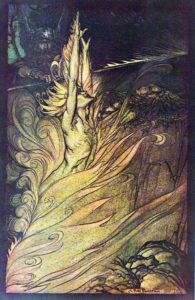
Wotan has summoned Loge to encircle the sleeping Brünnhilde with magic fire. Arthur Rackham (1867-1939). Illustration to Richard Wagner’s Die Walküre, from Der Ring des Nibelungen (The Ring of The Nibelung).
Wotan has summoned Loge to encircle the sleeping Brünnhilde with magic fire. Arthur Rackham (1867-1939). Illustration to Richard Wagner’s Die Walküre, from Der Ring des Nibelungen (The Ring of The Nibelung).
The essays had finally spent themselves by 1851. His mind was cleaned and ready to tackle his idea of the Gesammtkunstwerk, the (Total Work of Art) in his first “Music Drama” based on Norse and Germanic myths. He had read the Volsunga Saga, the Nibelungen Lied, the Norse Eddas of Snorri Sturluson—all the same source material that J.R.R. Tolkien in the early twentieth century would use to eventually write his Lord of the Rings trilogy with the idea of restoring to the English their lost, Germanic (Anglo-Saxon) myths.
Wagner had first written and abandoned a musical sketch for one Music Drama Siegfrieds Tod (Siegfried’s Death), but he couldn’t contain the vastness imagined in just one Music Drama. He then made the momentous decision to first write the epic poem himself expanding the narrative into four works, and did so not writing any principal music except for a few sketches of themes, as he wrote the epic poem for an ever expanding set of Music Dramas until finally the librettos were written with the following titles: Das Rheingold (The Rhine Gold), would be the planned prelude, followed by the three principal music dramas: Die Walküre (The Valkyrie), Siegfried and at last Götterdämmerung (the Twilight of the Gods). This tetralogy was all under the name Der Ring Des Nibelungen (The Ring of the Nibelungs). Like Tolkien’s ring of power so Wagner shaped his saga around a ring, but rather, forged by the Nibelung dwarf “Alberich” who had gained the power to steal the Rhine Gold from the three Rhine Maidens and fashion it through renouncing Love for Total Power over the world.
In review, preparation for Wagner’s Musical-Dramatic “Total Art Work” revolution required the psycho-drama dialogue of his essay period 1849-to-1851, followed through two further years of writing the four Librettos of the Ring Cycle’s epic poem (1851-1853). These preliminary steps taking four years at last gave him the word foundation for composing the attending music. What he did by writing the librettos himself, something opera composers never did, reminds me of the years James Cameron chose to dedicate to completing the movie scripts for the rest of his Avatar Saga, encouraged by the huge success of Avatar movie number one. And like Wagner, Cameron needed to build a foundation of written words to set his revolutionary musical emersions upon, his script writing gave him a foundation, a “story map,” to further his revolutionary emersion-cinematic inventions for his planned Avatar saga.
In November 1553, Wagner at last began the music composition draft of Das Rheingold. He was in Venice, the city that would be the inspiration catalyst for much of his later work. The moment came while he was lying on a sofa recovering from dysentery. Lulled by the Venetian canals outside his window, woozy with dizziness, he suddenly heard in the hum of light nausea buzzing in his ears, the first and deepest, primordial D-Major chord, sustained in the depths of the orchestra of his mind. Slowly it ascended from the depths of the Rhine River. Like the beginning of the world, it began to move, rising from sonic depths into the Nature motif, then the theme of currents and river waves followed, until the whole orchestra he sonically imagined breathed sound as if one espied in shafts of dawn’s glow in the sparkling ceiling of the surface-water’s end, the first glimpse of the naked water sprites, the four Rhine maidens, cavorting with each other in play as they began to sing!
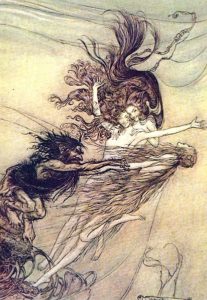
The Rhinemaidens (Woglinde, Wellgunde, Flosshilde) tease the dwarf Alberich as he reaches out for one of them. Illustration to Richard Wagner’s Das Rheingold, by Arthur Rackham.
Wagner’s 25-year journey and labor to bring the “music” out of the ethers and in to his 15-hour Drama, had just begun.
He was at last “in” to the Music that he’d let gestate for three long years, mostly in silence. In the next four years, he would steadily compose Das Rheingold, Die Walküre up to setting down Acts One and Two of Siegfried. Then he suddenly, unexpectedly put down his scoring pen. When he grasped it again, a moment later, it began writing a whole new music for a different Music Drama. It was a download from the beyond of the introductory music for Tristan und Isolde, with the famous Tristan cord now conjured. Wagner related that at one point he stared holding his swaying head and yelling at the beyond to slow down, that the flood of new music was coming too fast to set down on paper! One could say Neptune in “Piscean” transit had changed the signal with its medium to hear a new project and that this was a consequence of Wagner’s new love. A new muse was calling him away from his Nordic epic. She was the young and fetching poet, Mathilde Wesendonck, the wife of his chief benefactor in Switzerland at that time, Otto von Wesendonck. A lot of people tried to imagine this was some sexual affair. Wagner’s wife believed it was. Otto at times might have wondered but tolerated his young wife’s infatuation with her poetic muse, that was Wagner, their guest at his sprawling estate.
I had a friend, who was an authentic Wiccan Witch and teacher and a great opener of my being. She was like a muse. We did love each other but we never imagined it would become a sexual love affair. We were innocent of that and people misread our love. Her husband, a rock musician, imagined there had to be sex going on too. Everybody in the circle of friends believed it.
It was 1980. I would soon change my life course, go to India, be initiated as a Neo-Sannyasin disciple of my Master, Osho. I saw Tara later in 1981 when I had returned to Los Angeles all decked out in my maroon robes wearing my mala beads with a trinket of Osho’s portrait. Tara’s husband had divorced her and she proposed to become my lover reasoning, “since everyone thinks we were making love, why not make love now.”
To be entwined with my Occult mentor of long blond curls, her somewhat mannish face, slightly scared from running it through a windshield in an auto crash. Glass pieces sometimes popped out of her brows. Though her face was marred in interesting ways, her naked body was that of a Wiccan Goddess, stunning and statuesque. She was in my arms, the only thing between us being my mala beads and Osho’s portrait pressed into her naked belly. That was the first and last time we made love—and the last time I ever saw her to this day. She told me she was going on an adventure. I imagined it was something dangerous, probably a cannabis run over the border. She, all Aleister-Crowley-cryptically admonished her young man “not to seek her out.” But in good time she would “seek me.”
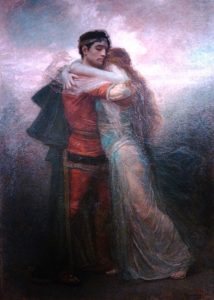
Tristan and Isolde by Rodelio de Equsquiza, who was a friend of Richard Wagner. Here’s a man who really “heard” the souls of Wagner’s characters, then set them to canvases.
Mathilde was a platonic inspiration to Wagner. There was no sexual punctuation at the end of their friendship’s sentence. No dot to foretell afterwards that a woman’s period had fortunately “appeared” with no pregnancy to explain to Herr Otto Wesendonck.
Mathilde Wesendonck gave Wagner pause from his Ring composing to write, arguably his most revolutionary Music Drama, Tristan und Isolde (Tristan and Isolde). He turned a new leaf despairing that the Ring Cycle was too big, too expensive, and too large ever to be performed. It was time for him to create more economical, single music dramas fit for any stage. And yet, being Wagner, Tristan would flood forth into a revolutionary challenge to stage and a far greater challenge for musicians to play, for he was taking harmony, with opening and floating musical key changes, to a chromatically rising and falling place where no musician’s ear, fingers on strings, lips on brass and woodwinds, had ever heard and played before.
Wagner put his work on the Ring away thinking he would never return to it. Eleven years and two masterpieces later, the hiatus ended, perfectly timed, for a European audience catching up to enjoying his earlier operas that were being more often performed across the continent. His banishment from German states had also ended. Wagner would resume work on his Ring Cycle in 1869. Mathilde the muse had long left his presence, though they remained good friends corresponding. The estranged Minna had passed away from heart failure.
Wagner had a new soulmate, Liszt’s daughter, Cosima, 24 years his junior. In November 1863 Cosima (age 26) and Wagner (at age 50) reported that “With tears and sobs, we sealed our confession to belong to each other alone.” This took place in a coach ride both shared through the streets of Berlin while her husband, Hans von Bülow, a committed devotee of Wagner and his music, was rehearsing a concert of it, unaware of the change of “heart” his wife and musical master had just had. Von Bülow conducted the premier of Tristan und Isolde in Munich (June 1865) and Wagner’s only comedy Music Drama, Die Meistersinger’s von Nuremberg (June 1868), also in Munich. Hans von Bülow would become one of the most significant conductors of the latter nineteenth century, abandoning his devotion for Wagner’s music for that of Johannes Brahms. He died on a concert tour in Cairo, Egypt, just before the century’s turn.
Wagner was apt to express more than one outrageous-though-sincere desire that would later be fulfilled. In early 1864, hounded by creditors, facing midlife, he wrote in a letter, “I am a “Prince of Artists” who needed a “Prince of the Blood as Patron.” He had no one specifically in mind. But not long after, the Prince manifested himself like in a fairy tale. He was the recently crowned, 18-year-old King Ludwig II of Bavaria, who would become Wagner’s greatest fan and patron. Ludwig had all of Wagner’s debts paid, freeing him of financial burdens so Wagner could just compose and complete his Ring.
However his affair with the conductor’s towering wife, walking the streets of Munich with her short lover by her side, made for great tabloid cartoons, gossip and scandal. Wagner had three children with Cosima von Bülow while her quietly suffering husband’s greater love for Wagner’s music kept him conducting his operas. Eventually King Ludwig heard about the affair and was quite angered. Wagner was exiled again, so to speak, facing his second exile in Switzerland, changing Swiss cities and lake place names from Zurich to a more picturesque town and city of Lucerne, renting the lakeside villa Triebschen. Ludwig bankrolled the rent and expenses, even visiting his “master” incognito from time to time to hear him play new music.
It was at Triebschen that Wagner enjoyed a domestic life and the love of his mistress. He had a family consisting of Cosima’s two daughters from Bülow and three daughters sired with Cosima and finally came a son. Divorce and marriage to Wagner was at last granted in 1870. Never sought was the happiness of home and hearth but it was richly given and happily received. Wagner never got over his joy of it. The joy of family life plus Cosima’s devotion to the man and his music, ended one more exile. That of his Ring Cycle. It had lasted 11 long years. Wagner resumed composing the Ring.
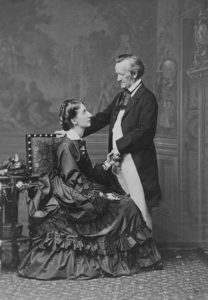
Cosima and Wagner, 1872.
Thank you for reading this free sample. Get full access to all six articles by choosing one of three options:
OPTION 1
GAIN FULL ACCESS NOW:
TO 12 MONTHS
OF HOGUEPROPHECY ARTICLES
Donate $60 or a little more to HogueProphecy.com and you will receive full access to 12 months of my bi-weekly posted reports sent directly to you. The HogueProphecy Report is going to give you bi-weekly postings of 2 to 4 articles at a time. A lot of my subscribers are very happy about this new arrangement, and I hope you will also join them by either choosing this option or by choosing the other two options. You’ll get articles as soon as they’re published. I will manually send a fully illustrated PDF attached to the email address you used at PayPal. 12-months and bonus 31 July 2023 articles free in the PayPal Memo line, to receive full access to this archived Article thread.
You can also join via snail mail. Just send a US check or money order payable to “John Hogue” of $60 or a little more to: John Hogue, P.O. Box 666, Langley, WA 98260. Please don’t forget to send a legible email address for sending these eMagazines.
OPTION 2
GAIN TOTAL ACCESS
TO ARTICLES AS THEY POST
Want to choose my postings one at a time when you can afford them? Here’s what you do. Donate $5.00 or a Little More, to sustain HogueProphecy. Put one-time in the PayPal memo line for 31 July 2023 HP Report. I will manually send a fully illustrated PDF attached to the email address you used at PayPal.
OPTION 3
THE BEST OPTION
SET UP AN AUTOMATIC PAYMENT
When you donate $5.00 or a little more, you will be taken through my website page to my PayPal donation page. Click on the monthly payment option and set up your bank or credit card to my PayPal account. Put Automatic and bonus 31 July 2023 Articles free in the PayPal memo line to receive full access to this archived Article thread. I will manually send a fully illustrated PDF attached to the email address you used at PayPal. You can then receive all access as long as you stay in the automatic monthly payment for days, months, or years. As long as you like. I think for many of you who haven’t renewed your subscription because paying the whole annual donation at once is too expensive, this could be the best and most affordable option that equally sustains my financial ability to keep publishing articles. Call it my own version of the “Substack” or “Patreon” model.
PREVIEW THE EXTRA ARTICLES
YOU WILL RECEIVE
DATELINE: 29 July 2023
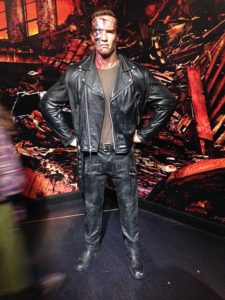
The Terminator at Madame Tussauds London, 1 November 2016. Source: Arnold Schwarzenegger as Terminator figure at Madame Tussauds London. Author Luke Rauscher, © Creative Commons.
EARTHTRAMUA REPORT:
The “Terminator” AKA “Conan the Barbarian” is Right:
Nobody gives a Sh*t About Climate Change
Time to Rebrand?
If I were to paraphrase one of the most famous and “darkly” medieval lines from the movie Pulp Fiction, I would go beyond medieval. I would say that the “Terminator” would like to go prehistorically Conan-the-Barbarian on Climate Change’s butt.
The filmmaker, action hero, champion body builder, and Hollywood acting pioneer boldly didn’t choose an easy-to-pronounce stage name but muscled his way playing on his strengths, knowing his weaknesses, to post on movie marquees his 14-lettered, Teutonic last name to stardom: S-c-h-w-a-r-z-e-n-e-g-g-e-r!
Ahh-nold, is also a passionate political activist and Climate Change crusader, although it is an odd pairing to see this former Republican Governor of California indirectly associated with the Green Puritanical leftist, tree-hugging, tomato soup defilers of museum paintings.
He sees that their marketing sucks.
One of the Green movement’s greatest weaknesses is in persuading people that there’s a serious problem with Climate Change which in 2015 Arnold Schwarzenegger rightfully defined as the “issue of our time” not to be politicized by politicians.
So Arnold dropped a truth bomb in his interview in Austria on 28 May 2023 with Tracy Smith for CBS Sunday Morning that aired on Sunday 2 June, in which he said climate change activitsts… Get 12 months of full access now to all my articles for only $60 or a little more.
DATELINE: 21 July 2023
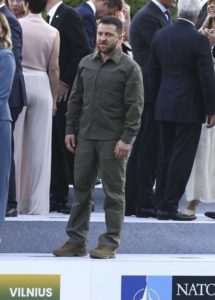
UKRAINIAN WAR REPORT
Part One
The Vilnius NATO Summit Assessed
I recall in 1991 I had a vision that was terrible as it was equally absurd. At the time there was fighting happening between Estonians and the Soviet forces who were leaving it at the end of the First Cold War. Ukraine was moving towards independence, but I noticed that Crimea, a historically Russian Oblast for 300 years, which was never truly part of Ukraine or its culture, which had only been moved into Ukraine by the Ukrainian “Soviet” Premier Khrushchev in 1955, would remain in the new “nationalistic” Russian-hating Ukraine, where the Russian Federation had a lease agreement to keep their military bases and strategic port of Sevastopol for the Russian Black Sea Fleet.
I was faced with two dire visions of the future, ignited by these two developing realities in 1991. I had to pass through five stages of grief to acceptance of what my Oracle had been pointing out, that Word War III would be triggered either by a crisis in dinky, insignificant Estonia and/or a dispute between Ukrainians and Russians over Crimea… Get 12 months of full access now to all my articles for only $60 or a little more.
DATELINE: 21 July 2023
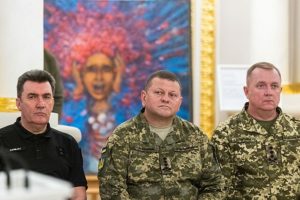
General Valery Zaluzhny (center) with a Ukrainian version of the famous Edvard Munch “Scream” painting behind his head. Maybe the painting resembles a reaction to what the General had recently said which is the subject of this article. Source: President of Ukraine Volodymyr Zelensky Official Website, © Creative Commons.
UKRAINIAN WAR REPORT
Part Two
Moscow’s Cautionary Warning to Washington:
You Arm a Loose Cannon, Duke Nuke’em Commanding General of Ukraine
“As soon as I have the funds, I will do something. I don’t give a damn—no one will stop me…!” Get 12 months of full access now to all my articles for only $60 or a little more.
DATELINE: 21 July 2023

Fire in a recreation center in Odessa Oblast (Ukraine) after Russian rocket strike on 17 August 2022. Most likely the recreation center hit nearly a year earlier than today similarly housed encamped masses of Ukrainian soldiers. Source: attributed to dsns.gov.ua. State Energency Service of Ukraine. © Creative Commons.
UKRAINIAN WAR REPORT
Part Three
Crimean Bridge Attacked / Odessa Port Facilities taken down by a Massive Russian Missile attack / A Russian Black Sea Blockade: A Cuban Missile Crisis Karmic Echo to the U.S.A. Cuba Quarantine? / Ukraine cannot Sustain this War much Longer / When the Kiev Regime will Collapse
Now, another thing going around in the press has to be clarified for Moscow’s sake. The attacks on the ports of Odessa Oblast and city where definitely not an act of revenge for the second bridge attack. The strikes were long planned for. The surgical extent of the damage proves it…
The Russians have apparently uncovered that many a ship arriving at Odessa Oblast’s ports to load Ukrainian grain, first downloaded weapons sent to Ukraine by NATO. It is only a coincidence of timing that had the Kerch bridge was struck again at the same time a further three-month renewal option came due with Moscow not renewing the grain deal for another three months, if ever again… Get 12 months of full access now to all my articles for only $60 or a little more.
DATELINE: 23 July 2023
UKRAINIAN WAR REPORT
Part Four
Poland Prepares a Move to Annex Western Ukraine
And President Vladimir Putin of the Russian Federation
Has Publicly stated What Russia will Do.

Former area border changes between 1938 and 1948. Bring your attention to the Polish Republic approximately at the center of this map because it will be the subject of this article. To the right is a long slab of Polish land in reddish pink that was absorbed into the Byelorussia and Ukrainian Soviet Socialist Republics after the German-Soviet partition of Poland in 1940. To compensate Poland’s loss of territory Joseph Stalin granted Poland all the historically German lands of Eastern Prussia and Silesia. Source of Map: en.wiki. Author: Mosedschurte. © Creative Commons.
Vladimir Putin…:
…The main thing is that formations of the Armed Forces of Ukraine suffered huge losses as a result of self-destructive attacks: tens of thousands of people.
And, despite the constant raids and the incessant waves of total mobilization in Ukrainian cities and villages, it is increasingly difficult for the current regime to send new soldiers to the front. The country’s mobilization resource is being depleted.
People in Ukraine are asking a legitimate question more often: for what, for the sake of whose selfish interests, are their relatives and friends dying. Gradually, slowly, but clarity comes.
We can see the public opinion changing in Europe, too. Both the Europeans and European elites see that support for Ukraine is, in fact, a dead end, an empty, endless waste of money and effort, and in fact, serving someone else’s interests, which are far from European: the interests of the overseas global hegemon, which benefits from the weakening of Europe. The endless prolongation of the Ukrainian conflict is also beneficial to it.
Judging by the actual state of affairs, this is exactly what today’s US ruling elites are doing. Anyways, this is the logic they follow. It is largely questionable whether such a policy is in line with the American people’s true, vital interests; this is a rhetorical question, and it is up to them to decide… Get 12 months of full access now to all my articles for only $60 or a little more.